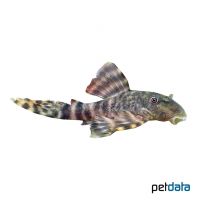Pleco L205 (Peckoltia sp. 'L205')
| Pleco L205 Peckoltia sp. 'L205' | |
|---|---|
| Name | Pleco L205 |
| Name Lat. | Peckoltia sp. 'L205' |
| Family | Suckermouth Armoured Catfishes |
| Family lat. | Loricariidae |
| Order | Catfishes |
| Order lat. | Siluriformes |
| Origin | Peru |
| Habitat | Tributaries, streams |
| Diet | Omnivore, soft wood |
| pH | 5.5-7.5 |
| Behavior | Peaceful |
| Keeping | Group |
| Care Level | Moderate |
| Reproduction | Cave spawner |
| Breeding | Difficult |
| Life Span | 5-8 years |
| Protection | No |
| Metric Units | |
| Size | 12-15 cm |
| Temperature | 25-29 °C |
| Hardness | 2-20 °dH |
| Aquarium | ~ 200 l |
| US Units | |
| Size | 4.7"-6" |
| Temperature | 77-84 °F |
| Hardness | 36-356 ppm |
| Aquarium | ~ 50 gal |
Distribution and habitat
The Ucayali Dwarf Shield Catfish L205 are common in the catchment area of the Rio Ucayali, a Peruvian headwaters river of the Amazon. They live in sections of the river with weak to medium current, preferring to live among dead wood and roots that protrude into the water.
Maintenance
The aquarium should have a robust planting, with stones and caves (catfish burrows) and roots that provide hiding places and at the same time are part of their diet. A sandy substrate, some subdued light (floating plants) and a weak current is ideal.
No ammonia, ammonium and nitrite should be detectable, the nitrate value should not exceed 100 mg/l. To ensure the water quality and oxygen content, a filter and heater adapted to the aquarium size is required, as well as lighting for the species-appropriate day-night rhythm of the animals.
Diet
They feed on plant and animal food. For a balanced diet, feed once a day with a high-quality dry food for loricariid catfish (granules, pellets, chips, tablets), supplemented with algae leaves, soft wood and fresh vegetables, such as zucchini, broccoli, bruised peas, scalded spinach, as well as zoopankton, cyclops, daphnia, artemia, mosquito larvae, etc. (live or frozen)
Feed only as much as will be eaten within a few minutes, excluding plant foods. Regular and varied feeding promotes health and increases resistance.
Behaviour and compatibility
The very peaceful and lively fish can be kept well with other peaceful fish in a community tank. Several dwarf shield catfish should always be kept together in a group.
Basically, only compatible fish species with similar demands on water conditions and water temperature should be socialized.
Sex dimorphism
Sexually mature males possess odontodes (pointed skin teeth). Females appear more rounded than the slimmer males.
Reproduction and breeding
There are isolated reports of successful breeding in the aquarium. They are cave breeders and the male does the brood care.
Important
Peckoltia sp. L205, which have a small iris lobe above the eye, are often confused with Peckoltia brevis.
Aquatic plants with soft leaves could be considered food.
When catching, use the finest mesh nets possible to avoid snagging the hard rays of the pectoral fins or the cutaneous teeth (odontodes) located on the bony plates, which can cause painful puncture wounds when touched.
The well-being of the fish should be checked regularly. Temperature should be checked daily, pH, hardness and nitrate levels at least every 14 days. Regular partial water changes are recommended, even when contaminant levels have not yet reached the upper limit. Sudden changes in water quality should be avoided. Newly introduced fish must be accustomed slowly to the water in the aquarium.
Further literature can be found in your pet store.
References
Text: petdata; Image: petdata
Source: BMELV (1998): Tierschutzgutachten - Haltung von Zierfischen (Süßwasser); ENGELMANN (2005): Zootierhaltung - Tiere in menschlicher Obhut: Fische, Verlag Harri Deutsch; SCHMIDT, WERNER, LECHNER (2005): MiniAtlas L-Welse, Bede Verlag
- Gemäß § 21 Abs. 5 Tierschutzgesetz idgF
